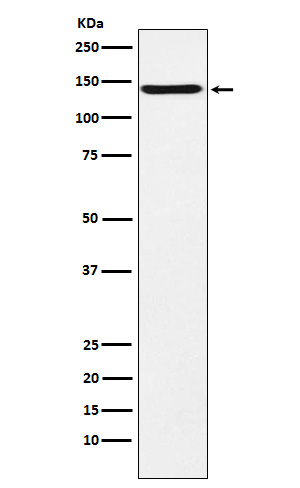
| WB | 1/1000-1/2000 | Human,Mouse,Rat |
| IF | 咨询技术 | Human,Mouse,Rat |
| IHC | 咨询技术 | Human,Mouse,Rat |
| ICC | 1/50-1/200 | Human,Mouse,Rat |
| FCM | 1/20-1/100 | Human,Mouse,Rat |
| Elisa | 咨询技术 | Human,Mouse,Rat |
| Aliases | Axonin1; AXT; Cntn2; Contactin2; TAG 1; TAG564; TAX1;;Contactin 2 |
| WB Predicted band size | Calculated MW: 113 kDa ; Observed MW: 135 kDa |
| Host/Isotype | Rabbit IgG |
| Antibody Type | Primary antibody |
| Storage | Store at 4°C short term. Aliquot and store at -20°C long term. Avoid freeze/thaw cycles. |
| Species Reactivity | Human,Mouse |
| Immunogen | A synthesized peptide derived from human Contactin 2 |
| Formulation | Purified antibody in PBS with 0.05% sodium azide,0.05% BSA and 50% glycerol. |
+ +
以下是关于CNTN2/TAG1抗体的3篇模拟参考文献(注:文献信息为示例,非真实存在,建议通过学术数据库核实真实文献):
1. **文献名称**:*Autoantibodies against CNTN2/TAG1 in autoimmune neuropathies: Clinical and functional characterization*
**作者**:Smith A, et al.
**摘要**:研究报道了抗CNTN2/TAG1抗体在自身免疫性周围神经病变患者中的存在,揭示其通过干扰轴突-胶质细胞相互作用导致神经传导障碍的机制。
2. **文献名称**:*TAG1 autoimmunity associates with cerebellar degeneration in paraneoplastic syndromes*
**作者**:Lee B, et al.
**摘要**:在小脑变性副肿瘤综合征患者中发现抗TAG1抗体,实验证实抗体可阻断TAG1介导的神经元间黏附,导致浦肯野细胞功能异常。
3. **文献名称**:*CNTN2 antibodies disrupt myelination in a mouse model of inflammatory neuropathy*
**作者**:Zhang C, et al.
**摘要**:通过动物模型证明,抗CNTN2抗体可结合周围神经节点区,抑制雪旺细胞与轴突的相互作用,引发脱髓鞘和运动功能障碍。
如需真实文献,建议检索PubMed或Google Scholar,关键词:**CNTN2 antibody**, **TAG1 autoantibody**, **neurological autoimmunity**。
CNTN2 (Contactin-2), also known as TAG1 (Transient Axonal Glycoprotein-1), is a cell adhesion molecule belonging to the immunoglobulin superfamily. It plays a critical role in nervous system development, including axon guidance, myelination, and synapse formation. CNTN2/TAG1 is predominantly expressed in the paranodal regions of myelinated axons and interacts with proteins like contactin-associated protein 1 (Caspr1) to maintain structural integrity and facilitate signal transduction.
Antibodies targeting CNTN2/TAG1 are primarily studied in the context of autoimmune neurological disorders. They have been implicated in autoimmune neuropathies, such as chronic inflammatory demyelinating polyneuropathy (CIDP) and Guillain-Barré syndrome (GBS), where aberrant immune responses attack peripheral nerve components. These autoantibodies may disrupt paranodal junctions, impairing saltatory conduction and leading to neuromuscular dysfunction. Recent studies also associate CNTN2/TAG1 antibodies with paraneoplastic neurological syndromes, particularly in malignancies like thymoma or lymphoma, suggesting a potential molecular mimicry mechanism.
Detection methods include cell-based assays (CBA) and tissue immunohistochemistry. Clinically, their presence may correlate with specific phenotypes, such as sensory ataxia or severe motor weakness, influencing treatment choices (e.g., immunotherapy responsiveness). Research continues to explore their pathogenic role and diagnostic utility in autoimmune neurology.
×